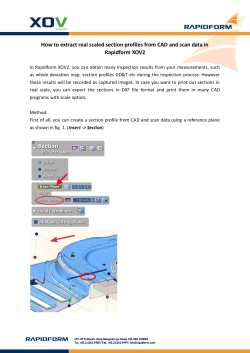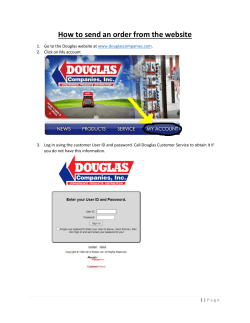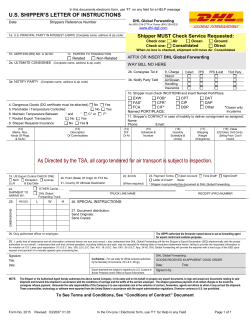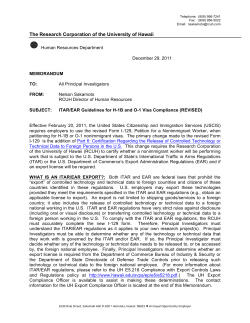
Guidelines for Export Plan Kingdom of Saudi Arabia
Kingdom of Saudi Arabia Ministry of Finance Saudi Industrial Development Fund Guidelines for Export Plan 1 Introduction This booklet has been prepared by the Export Consulting Unit (ECU), a section of the Marketing Studies & Consulting Division (MSCD) of the Saudi Industrial Development Fund (SIDF). The booklet has been designed to assist Saudi companies who are actively considering the prospect of developing their business opportunities in the export markets. It is intended to act as an aid to exporters and addresses a range of pertinent subjects that relate to preliminary information gathering in readiness for finalising the Export Plan – which forms part of the overall corporate marketing plan. A useful Export Plan must reflect the corporate activities directing the flow of business from the producer to the export markets. The export plan should identify workable mechanisms to achieve the overall export objectives. For the reasons indicated, careful perusal of this booklet will assist companies to:(a) (b) (c) (d) (e) Evaluate their level of commitment to exporting. Identify their export product/service potential. Help to better manage international business operations successfully. Communicate their corporate ideas to outside persons and businesses. Become well managed and directed as these businesses are more successful when working from an agreed and established business plan. 1 Part One The Importance & Objectives of the Export Plan Business planning is essential for any organisation that wants to approach the future with a detailed plan of action. Planning enables the management to think through potential business opportunities and threats that the company may face in the future and implement plans to develop the former and mitigate against the latter. Thus, a business plan helps an organisation to anticipate and plan for the future by taking well-informed decisions based on available data. For this reason, a plan must be reassessed regularly in order to keep it up-to-date – reviewing it at least once a year. Planning is a continuous process and it is easier to develop and further polish a business plan after the initial work plan has been established. The management should be committed to the company’s international business, market opportunities, and key aspects of the export markets. The purpose of an Export Plan is to prepare a company to enter the international markets. Much of the initial information gathered is necessary to decide on whether exports can be undertaken, without undue expenditure, from the office. An investment in time, of course, is necessary to ensure that sufficient information is gathered and made available to the management for making an informed decision on exporting. The key factors for management to undertake are:• • To decide whether the company has the product/service capacity available and the internal systems in place to export. To collect and evaluate the data available from public/private sector organisations and to clearly understand and implement the various procedures/systems necessary for exporting. In this respect basic information such as exporting procedures, trade statistics, country profiles can be collected from appropriate Government departments and agencies, local chambers of commerce and industry, banks, and trade associations, the internet, embassies, etc. 2 • An information gathering exercise to identify and determine the viability of exporting to selected countries. In this respect:o o Market research is a key factor and initially a desk study can be undertaken to select potential export countries and to identify potential markets, products, prices, competition, licensing procedures and duty/import regulations, and above all the international credit rating of the local public/private sector organisations – the latter determines the countries ability to pay for imported products/services. Once the desk study identifies specific countries, then visits to those countries can be undertaken to gather more detailed information and establish links with local businesses, before taking any further management decisions regarding exporting. Management Issues on Exporting Before any corporate decision can be made to export, it is essential that the management evaluate their reasons for exporting. A decision to export must be based on sound business reasons that will enhance and improve the company’s financial performance, expand its operations and develop/expand its product ranges. Developing an Export Plan is an ideal mechanism for a company to focus and assess its present market situation and develops an action plan for the future. It allows the company to:(a) Set short and long-term goals for itself. (b) Enable it to analyse its own industry objectives and direction, e.g. in terms of growth potential, competitiveness, etc. (c) Undertake an in-house SWOT analysis of the company to identify its strengths, weaknesses, opportunities and threats and those of its potential markets. (d) Consider the pros and cons of market expansion. (e) Focus on the most appropriate products/services it has available for the export markets. Apart from this, a series of other issues also need to be addressed by the management before a final corporate decision to export can be made. These can briefly be identified as:3 • Management Objectives o Management should be fully committed to a concerted, longterm export effort, it should not be based on short-term objectives. o The company's reasons for pursuing export markets should be based on solid objectives. o Management’s export expectations should not be shortsighted or short-termed as exporting is a long term objective. • Corporate Experience – what needs to be considered? o o o o o o o o o • Identify areas where export business has already been undertaken or where enquires indicate substantial potential. Conduct market research to select the right products and services that can offer the best export potential. Ascertain whether third-party sales are possible and to which countries. Identify sales channels. Identify main competitors. Establish the importance of acquiring ISO 9000 quality certification – many overseas companies will not buy otherwise. Ensure that products meet specific standards in the target market. Assess the advertising and promotion needs of the export markets. Understand the target country’s regulations in terms of tariffs, duties, taxes, labeling, packaging, etc. Management and Personnel – don’t forget the corporate structure. o o o Evaluate the current in-house expertise in export and identify any additional facilities/manpower needed (and at what cost) to grow the export capability of the company. Develop the operational structure and lines of authority for the export department. Identify and implement strategies necessary to set-up distribution/representation in selected export territories. 4 o o • Production Capacity o o o o o • Allocate senior management time to oversee and direct export facilities in the initial stages of exporting. Staff training is an important factor in corporate development and a range of training modules should be implemented to assist staff to export. Identify the current production/service capacity and the capacity levels available for export markets. With developing domestic and export markets, how easily can product/service capabilities be expanded to meet market demand and at what cost. Could any fluctuations in the annual demand be levelled out by better planning and warehousing. Calculate the minimum viable order quantity for orders placed to ensure corporate profitability. Ascertain any changes required to design packaging for products specifically for export. Financial Capacity o o o Determine the additional capital commitment required by the company to enter export markets. Take into account any new corporate development plans that may be in the design stages whose costs may compete with the company’s export plans. Work out the breakeven point for the extra corporate cost injection for exports to ascertain when profits can be generated. A management team committed to exporting will take sufficient time to work through and accurately address the above points. They will establish the levels of corporate commitment and responsibility the company is prepared to undertake to identify and develop expected export opportunities. Having taken a corporate decision to export, there is now a need to put the corporate export planning into a written format so it can be implemented and tracked over the coming years. 5 Business Planning and Timetable If an Export Plan is to be useful, it must reflect the company’s ideas, efforts and direction. The planning process forces a company to investigate its current and future business operations and anticipate the likely affect on the overall future business. It also allows a company to:(a) Identify key activities. (b) Compile a list of tasks that are vital for the successful operation of the business. (c) Assign responsibility for each activity, and (d) Determine scheduled start/completion dates for each of the activities. Based on these factors, a good Export Plan should set up the answers to the following strategic questions:BUSINESS ASSESSMENT STAGE 1 STAGE 2 STAGE 3 STAGE 4 STAGE 5 Where are we now Where do we want to be How might we get there Which way is best? How can we ensure arrival Present Status End Vision Mission Evaluation Control 6 For the reasons indicated, careful perusal of this booklet will assist companies to:(a) (b) (c) (d) (e) Evaluate their level of commitment to exporting. Identify their export product/service potential. Help to better manage international business operations successfully. Communicate their corporate ideas to outside persons and businesses, and Become well managed and directed as these businesses are more successful when working from an agreed and established business plan. 7 Part Two Export Plan Preparation Steps Export Business Plan – Outline and Content The purpose of the Export Plan is to prepare a company to enter the international marketplace. The layout of the Plan and its contents should generally follow the format indicated and the Plan should cover a period of, at least, 3 to 5 years – although long-term plans can cover a period of up to 10 years. A generally acceptable layout and content for a Plan is outlined in the following points:• Title Sheet and a Table of Contents • Executive Summary – a synopsis of the text of the company’s Export Plan that should be up to four pages maximum. It is important that the summary should be brief yet address all the major issues that are important, including:(a) (b) (c) (d) (e) (f) The reasons for exporting, The products/services selected for export, The target countries/markets with their respective supply/demand and market share data, Expected competition, Logistics and distribution network, and Market prices and perceived export profits to be generated. • Introduction – a brief summary addressing the reasons behind the company’s decision to export and the short, medium and long-term benefits of the export activities. • Section 1: Export Policy Commitment Statement – a precisely worded ‘mission statement’ stating very specifically the company’s policy and commitment to export. 8 • Section 2: Corporate Details – this section should provide some background information on the company and identify:o o o o o o • A brief history of the company, its products (description and function), and its major achievements. The most suitable and exportable products/services to be selected for sales internationally by the company – statement of why product is ready to export i.e. domestic product success, etc. Operational requirements and structure. Personnel and export organisation structure. Resources available from the company. Industry structure, competition, and demand in the home territory and reasons for exporting. Section 3: Marketing Component – this section should focus on the commercial/marketing aspect of the business plan, making sure to:o o o o o o o Identifying, evaluating, and selecting target markets in each selected territory – identify if any product modifications are needed. Selection of the appropriate range of products/services and respective pricing policy in each market. Identifying the most appropriate distribution methods available for each territory and selecting the most appropriate method that is suitable for the company and its products/services. With the assistance of local representatives and legal support, identify the most suitable Export Terms and Conditions of Sale and Supply which can be implemented by the company. Setting-up an internal organisation and a set of procedures for exporting. Setting sales goals and summary of Profit & Loss forecasts – sales goals evaluated against set quarterly and monthly goals in the initial stages and later on an annual basis. Identifying the challenges in the targeted country – business climate, culture, resources required, etc. 9 It is important to identify the most suitable and exportable products/services available from the company. The selected products/services should fill a targeted need in the export markets according to price, customer need and market demand. Most importantly, identify why the foreign buyers should purchase the company’s products/services instead of their competitors. • Section 4: Corporate Targets and Strategy – this section should clearly identify:o o o o o o • What background work, investigations and market research has been or is being undertaken to pinpoint suitably viable export territories. The parameters used to separate the identified countries into primary and secondary targets for the company’s marketing and sales activities. The range of indirect marketing efforts currently being or to be carried out to develop each of the selected export territories, e.g. steps taken to establish local representation, developing logistical & distribution, mechanisms & network, finalising corporate literature & brochures and the languages to be used, etc. The company’s tactics for entering, establishing and expanding their business potential in the selected target countries, e.g. through public relations and advertising, product branding, pricing policies, packing methodology, etc. How much inventory will need to be stocked by the company in order to sell overseas. Identify major threats and evolve a strategy to co-exist with competitors. Section 5: Export Budget – this section should clearly show the corporate expenditure to be incurred due to the company entering the export market. Financial statements should be prepared to cover the duration period of the Plan, stating all the project assumptions that have been made - 1st year’s details should be on monthly basis, 2nd/3rd year’s on quarterly basis and 10 the remaining years on annual basis. The financial statements should include:a) Balance Sheet b) Profit & Loss account c) Cash-flow analysis d) Any working capital requirements e) Business ratios f) Sensitivity analysis g) Disbursement and repayment schedule In the Export Budget, the company should only include costs that pertain to the international marketing efforts. Costs incurred for the domestic market should not be included. • Section 6: Implementation Schedule – this section should put a timescale for implementation of the various components identified/discussed in the Sections above. The schedule can then be used as a means to:o o • Follow-up on the implementation schedule for the Export Plan, and It can also be used as a periodic operational and management review (for measuring results against the Plan and its schedule). Section 7: Appendices Incorporating Background Data on Target Countries and Markets – this section incorporates the supporting documentation and evidence on which the Export Plan has been developed and built-up. The section should include, amongst other things:o o o o Basic market statistics - historical, current and projected. Background information and facts relating to the company and its selected export markets. Details of the supply/demand situations and the competitive/pricing environment. Any other relevant information. 11 Reviewing the Commercial Requirements of an Export Plan A. Marketing Strategy Step 1: Finalise the ‘Terms of Sale’ for export. Where should the products/services be made available – at the plant (exfactory), free-on-board (FOB), landed at the port of importation (CIF/C&F), or delivered free and clear to the customer’s factory/office. Note that this will determine the level of risk being taken by the company and its pricing strategy will depend on the ‘Terms of Sale’. Step 2: (a) Determine international pricing strategy. How the product/service price is driven in each export market, what factors need to be considered in setting prices, identify any products sensitive to price changes, type of pricing policy to be implemented (high profit/low turnover and/or low profit/high turnover), discount policies, etc. In calculating an export price, take into account all the cost factors that can affect the company’s profits. (b) The cost of goods sold is partly determined by pricing strategy and the ‘Terms of Sale’. Ensure that the cost of sales for each product/service are identified fully and also incorporate into these costs is the cost of the freight terms agreed with the customer. The company should allow a realistic price margin for unforeseen costs, unavoidable risks and simple errors that are common in any new undertaking. To minimise problems in this area, a good working relationship will need to be developed between the company and its freight forwarder. Step 3: B. Step 1: Define customer services. Any special customers services to be offered to the export market, type of payment options available, how are export returns handled, etc. Marketing Mix Select the best countries to market the company’s products by preliminary screening, through:- (a) demographic, 12 economic, political, and cultural data, (b) market factors relating to company’s products/services (market access, product potential, distribution, representation, etc), and (c) primary/secondary market research, etc. Step 2: Determine projected sales levels within each of the export territories selected – identify sales volumes, growth factors, profitability, etc. Step 3: Identify customers within chosen markets – most likely customers for the company’s product/service range, their requirements and usage profile. Step 4: Determine method of exporting – how other firms sell in to the market, selling will be direct to customers or via a third party (distributor/representative), will the company require permanent representation, how will the products be supported/serviced, etc. Step 5: Building a relationship with local distributors/agents – will a local representative be appointed, what facilities will the representative provide, what are the capabilities/strengths of the representative, setting and achieving targets, etc. Step 6: Set export prices which must be high enough to generate a reasonable profit, yet low enough to be competitive in the local marketplace. Basic pricing criteria (which are the same in all markets) are dependent upon the levels of costs, market demand, and competition within the specific local market. C. Step 1: Marketing Support To achieve efficient sales opportunities in the targeted markets, support facilities will need to be established, i.e. literature/brochures, while development of customer relations and requirements will also need to be addressed. Also product development should address local labelling requirements, language criteria, branding needs, public relations and advertising, etc. 13 Step 2: Identify literature requirements – what special concerns should be addressed in the sales literature to ensure quality and informative representation of company’s products, and are other printed or audio/visual presentations required (and in what format). Step 3: Identify customer requirements – delivery time, method of shipment, payment & warranty terms, servicing needs and requirements, etc. In writing an Export Plan, the company must identify any major constraints that may impact on the Plan in the short, medium or longterm. Examples of such limitations may be (a) a new or improved products about to enter the market, (b) likely price increases/reductions, (c) lack or loss of senior personnel, etc. All of these pertinent facts should be noted in a concise manner and precisely identified, in the appropriate sections of the Plan. It can, therefore, be seen that the Export Plan is part of the overall corporate strategic Business Plan. It expresses the company’s hopes and wishes for succeeding in the international marketplace. It becomes a working document containing the operational tools, procedures and the overall business control mechanisms for those involved in the marketing of the company’s products worldwide. Based on the information and guidelines provided in this booklet, an Export Plan can be compiled and completed in a professional manner by any company wishing to enter the export arena. However, it is also important for the company to ensure that it has suitably qualified personnel to implement the short, medium and long-term aspects of the Plan in a meaningful and positive manner. Finally, the Plan is a flexible document that can and should be adjusted regularly in line with changes in market and/or exporting circumstances. Good Luck 14
© Copyright 2025










